Leroy C., Rancoita P.-G. Principles Of Radiation Interaction In Matter And Detection
Подождите немного. Документ загружается.

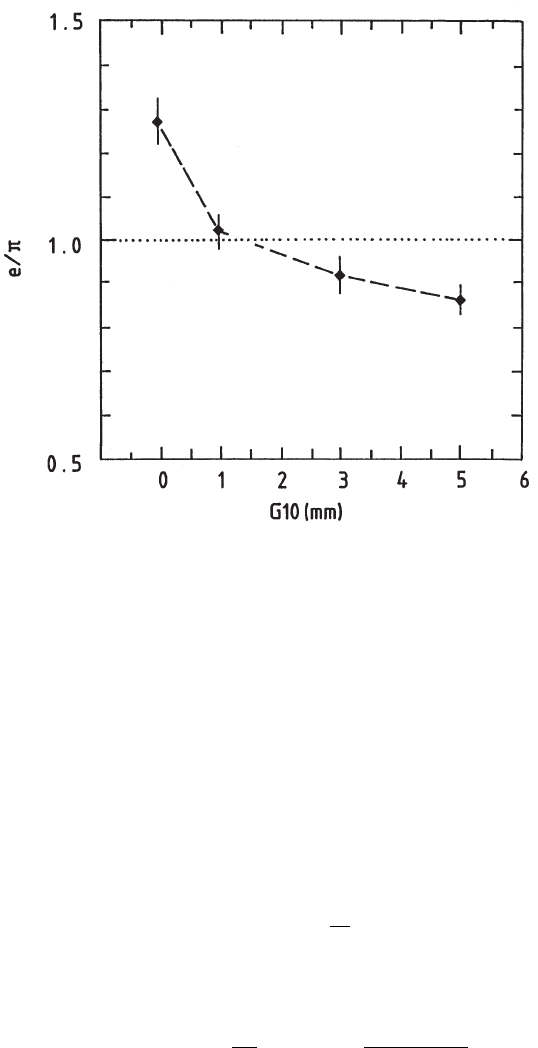
January 9, 2009 10:21 World Scientific Book - 9.75in x 6.5in ws-bo ok975x65˙n˙2nd˙Ed
690 Principles of Radiation Interaction in Matter and Detection
Fig. 9.25 Measured values of the e/π ratio for a Si/U calorimeter (see text) versus the thickness
of additional G10 plates (reprinted from Phys. Lett. B 242, Angelis, A.L.S. et al., Evidence for
the compensation condition in Si/U hadronic calorimetry by the local hardening effect, 293–298,
Copyright (1990), with permission from Elsevier, e.g., for the list of the authors see [SICAPO
Collab. (1990a)]; see also [Leroy and Rancoita (2000); SICAPO Collab. (1991b)]). The line is to
guide the eye.
The local hardening effect was achieved and studied for low-Z materials such
as G10, Al and polyethylene. The reduction of the electromagnetic visible-energy
depends, to some extent, on the thickness and type of the readout layers. In fact, for
typical detector thicknesses of 400 µm silicon, 2.5 mm scintillator and 2 mm liquid
argon, mip’s (which can be considered as scale units for energy deposition of fast
particles) deposit ≈ 140, 500, and 440 keV, respectively, while the low-Z absorbers
(for the local hardening effect) act mainly on soft electrons, generated in regions of
the high-Z passive samplers very close to surfaces adjacent to the active readout
media. This generated visible-energy reduction,
∆²
²
(low−Z), is almost independent
of the sampling fraction (Sect. 9.2.3), i.e., of the thickness of the high-Z passive
absorber.
From Eq. (9.66), we introduce the fraction R
lh
(low−Z) defined as:
R
lh
(low−Z) = 1 −
∆²
²
(low−Z) =
²
vis
(low−Z)
²
vis
. (9.69)
R
lh
(low−Z) is independent of the thickness of the passive sampler, but depends on

January 9, 2009 10:21 World Scientific Book - 9.75in x 6.5in ws-bo ok975x65˙n˙2nd˙Ed
Principles of Particle Energy Determination 691
the thickness (and the location, i.e., in front or at the rear, see Sect. 9.2.3) of the
low-Z material added for achieving the local hardening effect.
Let us consider incoming electrons and protons on calorimeters which have diffe-
rent high-Z thicknesses U and U
0
, respectively. The ratio of the two e/π calorimeter
ratios can be written as:
R(e/π) ≡
e/π(U, low−Z)
e/π(U
0
, low−Z)
=
²
vis
(e, U, G10)
²
vis
(e, U
0
, G10)
²
vis
(π, U
0
, G10)
²
vis
(π, U, G10)
. (9.70)
From Eqs. (9.6, 9.69), the electromagnetic visible-energy becomes:
²
vis
(e, U, G10) = ²
vis
(e, U) R
lh
(G10) = R
lh
(G10) (e/mip) E
s
(U), (9.71)
where R
lh
(G10) is almost independent of the sampling frequency (i.e., independent
of the thickness of the high-Z passive sampler) and, as discussed in Sect. 9.2.2,
e/mip becomes independent of the sampling frequency, τ , for values of τ larger
than ≈ 0.8. Thus we have:
²
vis
(e, U, G10)
²
vis
(e, U
0
, G10)
'
E
s
(U)
E
s
(U
0
)
.
This way, the ratio R( e/π) of Eq. (9.70) can be written as:
R(e/π) '
E
s
(U)
E
s
(U
0
)
²
vis
(π, U
0
, G10)
²
vis
(π, U, G10)
. (9.72)
Figure 9.26 shows the ratio R(e/π) for silicon calorimeters with U sampler
2.5 cm (data from [SICAPO Collab. (1995a)]) and 1.5 cm thick (data from [SICAPO
Collab. (1990a)]) as function of the added G10 plate thickness. The ratio
E
s
(2.5 cm U)/E
s
(1.5 cm U) was calculated by means of Eq. (9.4). The ratios
²
vis
(π, 1.5 cm U, G10)/²
vis
(π, 2.5 cm U, G10) were evaluated from an average (over
the incoming hadron energies of 8, 10, and 12 GeV) of the measured visible ener-
gies in the two experiments mentioned above. Experimental data indicate that the
R(e/π) ratio is quite consistent with 1, namely the e/π ratio does not depend on
the thickness of the uranium passive samplers, but on the thickness of the added
low-Z absorbers.
Once the compensating condition or an almost compensating condition (as a
result of the local hardening effect) is achieved in calorimeters marginally sensitive
to the energy carried by neutrons, it becomes possible to vary the calorimeter sam-
pling frequency, while keeping the e/h ratio almost consistent with 1. Thus unlike
the case of active detectors with hydrogeneous materials, we can operate compen-
sating calorimeters in which the ratio of the thicknesses of passive samplers to active
readout media is variable. In this way, it is possible to vary the contribution of sam-
pling fluctuations to the overall calorimeter energy resolution (see next section) by
modifying the sampling frequency, but keeping the compensation condition.
The achievement of the compensation condition, in the case of an absorber made
of Pb and Fe, results from the exploitation of the filtering effect. This was demon-
strated and systematically studied by an experiment performed by the SICAPO

January 9, 2009 10:21 World Scientific Book - 9.75in x 6.5in ws-bo ok975x65˙n˙2nd˙Ed
692 Principles of Radiation Interaction in Matter and Detection
Collaboration [SICAPO Collab. (1992a, 1993a)], using silicon detectors as readout
medium. The sampling hadron calorimeter consisted of sets of absorbers made of Fe
or Fe and Pb plates, interspaced with silicon readout mosaics. In each sampling, the
thickness of Pb and Fe, as well as the respective positions of the absorbers plates,
are kept constant. Each set of absorbers is 23 mm thick. The mosaic supporting
structure is equivalent to ≈ 2.5 mm thick Fe absorber and this thickness has to
be added to the overall thickness of the sampling absorbers. The incoming particle
energies are 6, 8, 10, and 12 GeV. The energy deposited by the incoming electrons
and pions was measured for the F-configuration FePb–Si–FePb [²
vis
(F)] and for the
R-configuration PbFe–Si–PbFe [²
vis
(R)], where a reduction of the visible energy is
expected, as a consequence of the filtering effect [SICAPO Collab. (1993a,c)] (see
Sect. 9.3). In both configurations, the thickness of Pb was varied from 3 mm to
13 mm. The thickness of Pb was kept constant inside each sampling in each confi-
guration. Data were also taken with Fe as the only absorbers for comparison.
Let us define the ratio
R
FR
=
²
vis
(F)
²
vis
(R)
.
For incoming electrons, we have that the value of R
FR
corresponds to the ratio of
the e/mip values for the F- and R-configurations [see Eq. (9.15) and Sect. 9.3.1],
because the shared energy, E
s
, does not depend on the sequence of absorbers [see
Eqs. (9.4, 9.5)]:
R
FR
(e) =
²
vis
(e, F)
²
vis
(e, R)
=
e/mip(F)
e/mip(R)
. (9.73)
R
FR
(e) was found to increase almost linearly (Fig. 9.11) as a function of the Pb
thickness, above a few mm of Pb absorber, when the filtering effect is acting.
For hadronic cascades we have to remember that the filtering effect acts on the
electromagnetic component of the hadronic shower, and that ²
vis
(h, F) ≈ ²
vis
(h, R)
and E
s
(F) = E
s
(R), since there is no change of the thickness of samplers (passive
and active) in the two configurations, but only an interchange of the passive sam-
pler lo cations. As a consequence, h/mip values are unaffected. The second term of
Eq. (9.67) can be neglected, when the equation expresses the visible-energy reduc-
tion for the case of the filtering effect; namely the visible-energy reduction between
the F- and the R-configuration is expressed by Eq. (9.68). This equation can be
rewritten as a function of electromagnetic visible energies as:
∆²
²
(π, FR) ≡
·
²
vis
(π, R) − ²
vis
(π, F)
²
vis
(π, R)
¸
=
·
1 −
²
vis
(π, F)
²
vis
(π, R)
¸
= 1 − R
FR
(π) ≈ e/π(R) f
em
∆²
²
(e, FR)
= e/π(R) f
em
·
1 −
²
vis
(e, F)
²
vis
(e, R)
¸
= e/π(R) f
em
[1 − R
FR
(e)], (9.74)
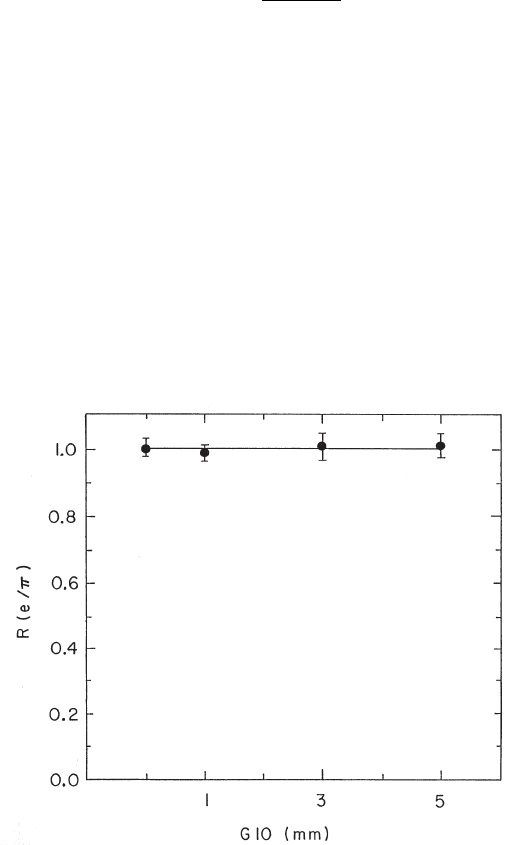
January 9, 2009 10:21 World Scientific Book - 9.75in x 6.5in ws-bo ok975x65˙n˙2nd˙Ed
Principles of Particle Energy Determination 693
where
R
FR
(π) =
²
vis
(π, F)
²
vis
(π, R)
and e/π(R) is the e/π ratio of the R-configuration; finally, we have:
R
FR
(π) ≈ 1 − e/π(R) f
em
[1 − R
FR
(e)]. (9.75)
The mean energy deposited in the calorimeter ²
vis
(e) (found to be linear as a
function of the incident energy, e.g., see Figs. 9.9 and 9.10) decreases with the thick-
ness of Pb in the absorber. Using identical passive absorber thicknesses, the values
of the visible-energy, measured with the PbFe–Si–PbFe R-configuration [²
vis
(R)],
are lower than those measured with the FePb–Si–FePb F-configuration [²
vis
(F)] for
incoming both electrons and pions, as expected because of the filtering effect.
For instance, the ratio R
FR
(e) for incoming electrons is 1.23 ± 0.05 for a Pb
thickness of 13 mm. The e/π(R) ratio (Fig. 9.27), measured for the PbFe–Si–PbFe
configuration with 13 mm of Pb plates, is 0.89 ± 0.01 [SICAPO Collab. (1992a,
Fig. 9.26 The ratio R(e/π) (reprinted from Nucl. Instr. and Meth. in Phys. Res. A 361,
Furetta, C., Leroy, C., Pensotti, S., Penzo, A. and Rancoita, P.G., Experimental determination
of the intrinsic fluctuations from binding energy losses in Si/U hadron calorimeters, 149–156,
Copyright (1995), with permission from Elsevier; see also [Leroy and Rancoita (2000)]) for a U
sampler 2.5 cm (data from [SICAPO Collab. (1990a)]) and 1.5 cm (data from [SICAPO Collab.
(1995a)]]) thick versus the added G10 plates thickness (on the front and on the rear the silicon
mosaics). The silicon mosaics had supporting structure made by two G10 sheets of 0.2 and 1 mm
thick, respectively. The line represents R(e/π) = 1.
January 9, 2009 10:21 World Scientific Book - 9.75in x 6.5in ws-bo ok975x65˙n˙2nd˙Ed
694 Principles of Radiation Interaction in Matter and Detection
1993a)]. Furthermore, for instance at 6 [12] GeV, the expected average fraction of
the converted electromagnetic energy in a pion cascade is f
em
≈ (20–22)% [(27–
30)%], with an average value among 6, 8, 10 and 12 GeV of ≈ (24–26)%. Using
Eq. (9.75), and measured e/π(R), R
FR
(e) and calculated f
em
ratios, the estimated
value of R
FR
(π) for incoming pions becomes:
R
FR
(π) ≈ 1 − 0.89 × 0.25 × (1 − 1.23) ≈ 1.05.
This latter value is quite consistent within with the measured ratio:
R
FR,measured
(π) = 1.06 ± 0.03.
The different rate of reduction of the visible energy for electrons and pions al-
lows to tune the e/π ratio and, therefore, to achieve the compensation condition in
a Si/Pb+Fe hadron calorimeter. A fundamental characteristic of the filtering effect,
in PbFe–Si–PbFe calorimeters, is the linear decrease of the e/mip ratio as the Pb
fraction, f [Eq. (9.14)], increases (Sect. 9.3). This dependence on f was experimen-
tally observed [SICAPO Collab. (1989c)] for the entire f -range investigated, namely
for f values between ≈ (5–36)%.
The e/π values for the PbFe–Si–PbFe R-configuration (from an average of mea-
surements performed at incoming particle energies of 6, 8, 10, and 12 GeV) are
shown in Fig. 9.27 (from [SICAPO Collab. (1992a)]) as a function of the thickness
of Pb in the Pb+Fe absorber. It is observed that the e/π ratio decreases from the
value 1.11 ± 0.02, when Fe is the only Fe absorber, to the value 0.89 ± 0.01 for a
Pb thickness of 13 mm. From these experimental data, the thickness of Pb to be
inserted in the absorber in order to achieve the compensation condition (e/π = 1)
is estimated to be (5.4 ± 1.0) mm. The Pb thickness of (5.4 ± 1.0) mm corresp onds
to a fraction f of Pb present in the absorber of about (22–24)% (in calculating this
fraction, the thickness of Fe takes into account the amount of material serving as
support of the silicon mosaics). This experimental result is in agreement with the
prediction, based on Monte-Carlo simulations, for which the compensation has to
be achieved for f ≈ 25% in a PbFe–Si–PbFe calorimeter with Fe absorber thickness
of about 35 mm [SICAPO Collab. (1989c)] (see also [Brau and Gabriel (1989)]).
Other quasi compensating calorimeters using values of f between ≈ (20–25)%
were operated [SICAPO Collab. (1995b, 1996)]. Among these compensating (or
almost compensating) calorimeters, the minimal thickness of Fe absorber sampler
used is ≈ 15 mm (i.e., ≈ 0.85 X
0
). In general, the ratios of the thicknesses of Pb
absorbers to Fe absorbers (for which the compensation condition was achieved) are
≈ 0.94, when the ratio is calculated in units of radiation lengths, and ≈ 0.29, when
the ratio is calculated in units of interaction lengths.
Once the appropriate value of f is maintained (as well as the configuration) for
keeping the compensation, the overall passive sampler thickness can be readjusted,
i.e., the thicknesses of passive samplers can be varied to modify the sampling fluc-
tuations contribution to the overall hadronic energy resolution (see next section).
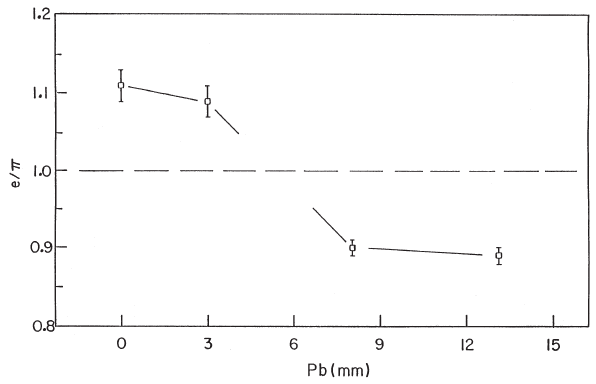
January 9, 2009 10:21 World Scientific Book - 9.75in x 6.5in ws-bo ok975x65˙n˙2nd˙Ed
Principles of Particle Energy Determination 695
The filtering effect can also act, when other low-Z and high-Z materials are
combined as passive samplers (Sect. 9.3). The value of f, required to achieve the
compensation condition, depends on the h/mip ratio of the calorimetric structure. In
fact, this value is related to the calorimeter response to the purely hadronic energy,
i.e., also to the type of active detectors. As a consequence, the ratio (of ≈ 1) between
the radiation lengths of Fe and Pb absorbers needs to be optimized, when replacing
silicon readout with other active detectors.
The e/π ratios measured in the FePb–Si–FePb F-configuration (see [SICAPO
Collab. (1993a,c)]) never achieved values close to compensation, except when the
Pb thickness inserted in the absorber represents a fraction (f ) larger than 50%. The
decrease of the e/π ratio value, in the case of the FePb–Si–FePb F-configuration,
is expected because the e/π ratio value for the Pb absorber is lower than the one
for the Fe absorber. Thus, as the Pb fraction increases the overall e/π value has to
decrease slightly. However, the compensation condition is not reached without a fur-
ther reduction of the calorimeter response to the electromagnetic component. This
reduction is achievable by exploiting the propagation properties of the electromag-
netic shower in complex absorbers (as discussed above and in Sect. 9.3).
These exp erimental results were reproduced by simulations [Giani (1993)] using
the GEANT program code [Brun et al. (1992)] and the FLUKA package [Aarnio
Fig. 9.27 The e/π ratio for PbFe–Si–PbFe R-configuration as a function of the thickness of
Pb absorber in the passive sampler (the overall thickness, including the Fe plate, of the passive
sampler is 23 mm). The data are from an average at incoming particle energies of 6, 8,10, and
12 GeV (reprinted from Phys. Lett. B 280, Borchi, E. et al., Evidence for comp ensation in a
Si/(Fe, Pb) hadron calorimeter by the filtering effect, 169–174, Copyright (1992), with permission
from Elsevier, e.g. for the list of the authors see [SICAPO Collab. (1992a)]; see also [Leroy and
Rancoita (2000)]). The line is to guide the eye.

January 9, 2009 10:21 World Scientific Book - 9.75in x 6.5in ws-bo ok975x65˙n˙2nd˙Ed
696 Principles of Radiation Interaction in Matter and Detection
et al. (1987)] for the hadronic interactions (see also [Hirayama (1992)]). These si-
mulations, using the geometry and the exact composition of the sampling material
(at the 1% level) of the experimental setup, have yielded results which are in go od
agreement with the measured e/π ratio values for both configurations [SICAPO
Collab. (1993a)]. The simulations indicate that the precise knowledge of the com-
position of the supporting structure is a very important element for determining
the agreement between experimental and Monte-Carlo data.
The local hardening and filtering effects can be combined. Soft electrons survived
to the filtering effect in Pb-Fe samplers can be absorbed by additional thin (in units
of radiation lengths) low-Z plates inserted in the calorimeter configuration next to
the active detectors.
As already discussed (e.g., see Sect. 9.2.3), the local hardening effect modi-
fies the e/mip ratio, also when other active media, like plastic scintillators, are
employed. The maximum achievable e/mip ratio reduction was estimated [Wig-
mans (1988)] to be ≈ 8% by EGS4 Monte-Carlo calculations. For instance, the
Reconfigurable-Stack calorimeter (see [Byon-Wagner (1992); Beretvas et al. (1993);
Job et al. (1994)], and references therein) used plastic scintillators as readout media
and a combination of Pb (3.2 mm thick) and Fe (25.4 mm thick) absorbers as passive
samplers, with a value f ≈ 11%. The plastic scintillators were cladded with 1.6 mm
Al plates, in order to vary the mip ratio by exploiting the local hardening effect. The
measurements [Job et al. (1994)] using F- and R-configuration have shown that the
e/π ratio at 10 GeV was decreased by ≈ 0.17 (with respect to the one measured with
the F-configuration), reaching the value of 1.10 ± 0.03 with the R-configuration.
9.10 Compensation and Hadronic Energy Resolution
The particle multiplication in calorimeters is based on statistical processes (although
due to different types of interactions in matter) for both electromagnetic, already
discussed in Sect. 9.4.1, and hadronic cascades. In sampling devices the hadronic
visible-energy depends (Sects. 9.8, 9.9) on the number of secondary ionizing parti-
cles and on particles (like fast neutrons) able to produce ionizing recoil protons in
hydrogeneous active media or ionizing recoil nuclei in any other detectors. Statisti-
cal fluctuations (e.g., see [Amaldi (1981); Fabjan (1985a, 1986)]) of the number of
created and recoil particles cause fluctuations of the visible-energy deposited in the
readout detectors and, consequently, limit the obtainable energy resolution which,
for an incoming hadron with energy E, is given by
σ(E)
E
≡
σ(²
vis
)
²
vis
(π)
, (9.76)
where σ(²
vis
) is the standard deviation of the distribution of the hadronic visible-
energy ²
vis
(π).
Because of the statistical nature of the cascade phenomenon, the energy reso-

January 9, 2009 10:21 World Scientific Book - 9.75in x 6.5in ws-bo ok975x65˙n˙2nd˙Ed
Principles of Particle Energy Determination 697
lution is expected to improve, that is σ(E)/E decreases, with the increase of the
energy. In electromagnetic sampling calorimetry (Sect. 9.4), we have seen that the
linear relationship between the incoming energy and the visible energy determines
both the 1/
√
E dependence of the energy resolution and the Gaussian-like distri-
bution of ²
vis
(e).
For hadronic fully contained showers, the resulting visible-energy distribution is
almost Gaussian (deviations may occur in the tail of the distribution [Fabjan et al.
(1977)]) with a peak located at the position of the mean visible-energy. However,
generally the energy resolution does not scale as 1/
√
E. Therefore in hadronic
calorimetry, the energy resolution is worsened.
In sampling calorimeters, only a small fraction of the visible energy is de-
posited in readout detectors. As in sampling electromagnetic devices, fluctuations
in the number of crossed active samplers by ionizing particles and in the deposited
energy by collision loss processes mostly contribute to broaden the visible-energy
distribution and to build up the so-called sampling fluctuations (e.g., [Amaldi
(1981); Wigmans (1987)]). Furthermore, a non-negligible fraction of the incoming
energy is invisible (see Sect. 3.3.1), since it is spent in processes like the nu-
clear break-up. Fluctuations in the amount of this invisible energy result in the
enlargement of the visible-energy distribution and constitute the intrinsic resolu-
tion (e.g., see [Amaldi (1981); Fabjan (1986); Wigmans (1987); Br¨uckmann et al.
(1988); Fesefelt (1988)]). These nuclear processes (as discussed in Sect. 3.3) are
not present in electromagnetic showers. In hadronic cascades, the visible energy,
²
vis
(π), is usually no longer proportional to the incoming hadron energy, since there
is always an electromagnetic component, whose fraction varies with the energy
(Sect. 3.3). This fraction, f
em
, undergoes fluctuations on an event-to-event basis
(see Sect. 3.3.1 and, e.g., [Amaldi (1981); Fabjan (1985a, 1986); Wigmans (1987);
Fesefelt (1988); Wigmans (1988)]). As the e/π ratio becomes quite different from
1 (i.e., as the calorimeter becomes less and less compensating), the contribution,
of fluctuations of a non-Gaussian nature, to f
em
is more and more important and
affects the 1/
√
E behavior of the energy resolution. This latter one, in turn, be-
comes related to the e/π ratio [Amaldi (1981); Wigmans (1987)]. In Figs. 9.28 and
9.29, measured hadronic energy resolutions are shown for a calorimeter employing
hydrogeneous readout [Catanesi et al. (1987); HELIOS Collab. (1987); Acosta et al.
(1991)] and for silicon readout [SICAPO Collab. (1996)]. The data indicate
k
that
the calorimeter energy resolution scales as 1/
√
E, but an additive term is present for
non compensating calorimeters. This term increases, as expected, as the calorimeter
becomes less and less compensating.
The energy resolution σ(E)/E of a sampling hadron calorimeter (when instru-
k
These data were confirmed by other measurements, e.g., see [Bleichert et al. (1987); Baumgart
et al. (1988a); Ros (1991); Wigmans (1991); Fabjan (1995b); SICAPO Collab. (1995a,b)] and
references therein.
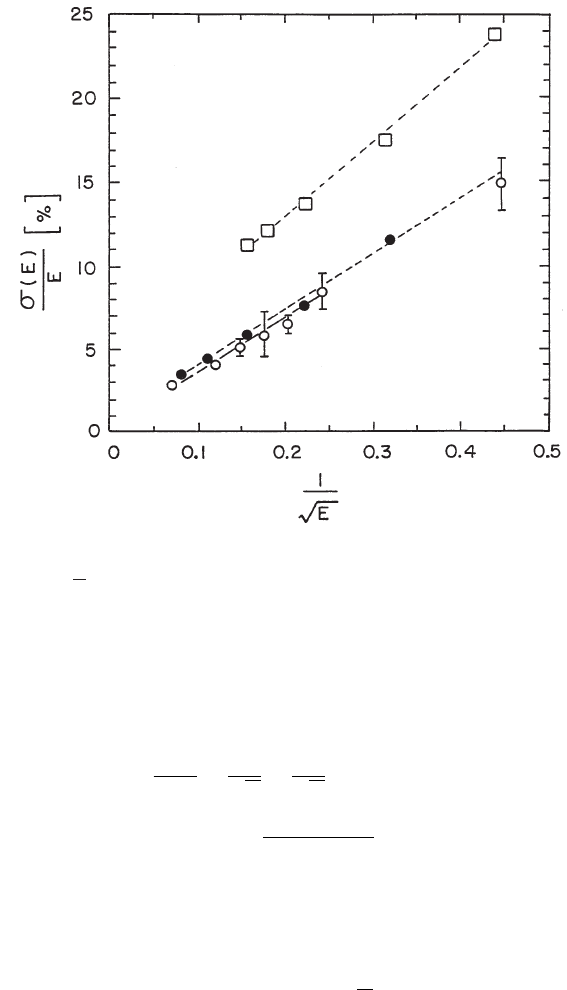
January 9, 2009 10:21 World Scientific Book - 9.75in x 6.5in ws-bo ok975x65˙n˙2nd˙Ed
698 Principles of Radiation Interaction in Matter and Detection
Fig. 9.28 Energy resolution σ(E)/E in [%] measured by calorimeters with hydrogeneous detectors
as a function of 1/
√
E, where E is the incoming hadron energy in GeV (from [Leroy and Rancoita
(2000)]): uranium/scintillator (◦) compensating calorimeter [HELIOS Collab. (1987)]; data cor-
rected for effects of light attenuation from the lead/scintillating fiber (•) calorimeter [Acosta et al.
(1991)] (with e/π ∼ 1.1 at 10 GeV), uranium/scintillator (2) calorimeter [Catanesi et al. (1987)]
(with e/π ∼ 0.8 at 10 GeV). The lines are to guide the eyes.
mental contributions can be neglected) is expressed as [Wigmans (1987, 1988, 1991)]:
σ(E)
E
=
C
√
E
=
C
0
√
E
+ φ(e/π), (9.77)
where E is the incoming hadron energy in GeV;
C
0
=
q
σ
2
intr
+ σ
2
samp
contains the contributions from the intrinsic resolution (σ
intr
), mostly due to nuclear
binding energy-losses, and from the sampling fluctuations (σ
samp
), added in quadra-
ture; the function φ(e/π) takes into account effects related to non compensation;
and, finally,
C = C
0
+ φ(e/π)
√
E.
In Eq. (9.77), the function φ(e/π) is called the constant term and dominates the
energy resolution at high energy, since C
0
is almost independent of energy. Expe-
rimental data show that φ(e/π) vanishes, when the compensation condition is
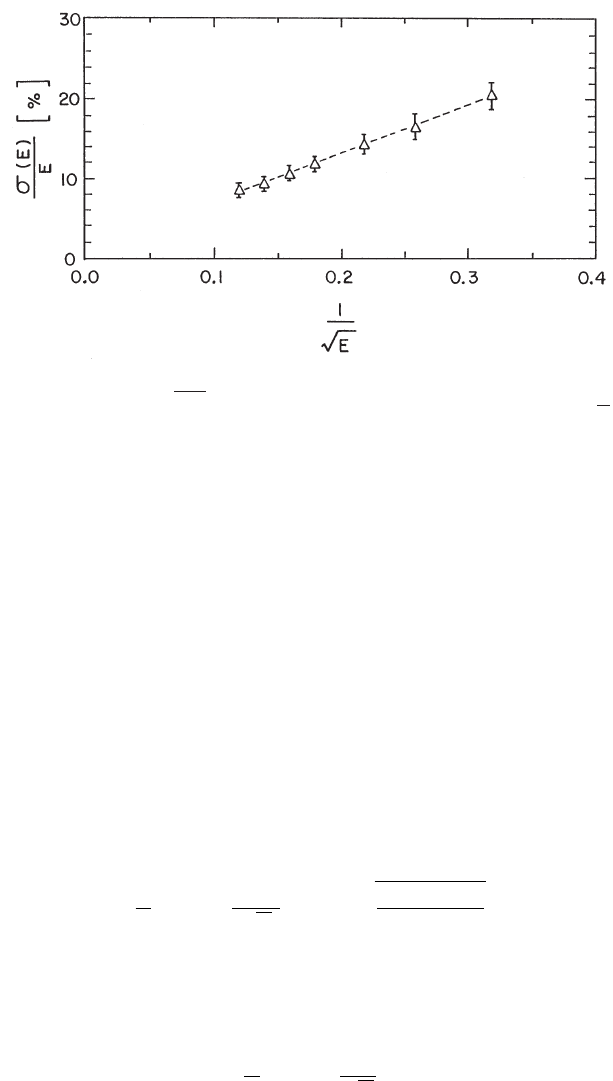
January 9, 2009 10:21 World Scientific Book - 9.75in x 6.5in ws-bo ok975x65˙n˙2nd˙Ed
Principles of Particle Energy Determination 699
Fig. 9.29 Energy resolution,
σ(E)
E
in [%], measured by an almost compensating PbFe–Si–PbFe
calorimeter and corrected for the effects of visible-energy losses as a function of 1/
√
E, where
E is the incoming hadron energy in GeV (from [Leroy and Rancoita (2000)]; data from Table 1
of [SICAPO Collab. (1996)]). The line is to guide the eyes.
achieved, i.e., φ(e/π ∼ 1) ∼ 0. One can also fit the experimental data to an expres-
sion that adds the scaling and the constant term in quadrature (see e.g., [Catanesi
et al. (1987); Young et al. (1989); Acosta et al. (1991); Fabjan (1995b)] and referen-
ces therein). However, it is interesting to note that WA80 Collaboration obtained
results, favoring Eq. (9.77) over a very wide range and up to high energies [Young
et al. (1989)].
As mentioned before, the small fraction of the energy sampled in the active sam-
plers is at the origin of sampling fluctuations σ
samp
. Their contribution to the over-
all energy resolution [Eq. (9.77)] was measured [Fabjan et al. (1977)] for low-A and
high-A passive samplers and found to depend on the amount of energy lost in a pas-
sive sampler (e.g., see [Fabjan and Ludlam (1982)]). Further measurements [Tiecke
(1989); Drews et al. (1990)] have confirmed such a dependence (e.g., [SICAPO Col-
lab. (1995a,b, 1996)]). The contribution to the energy resolution from sampling
fluctuations can be written as [Drews et al. (1990)]:
³
σ
E
´
samp
=
σ
samp
√
E
≈ 0.115
r
∆²
mip
[MeV]
E
, (9.78)
where ∆²
mip
is the energy deposited by a minimum ionizing particle (mip) in a pas-
sive sampler, whose thickness is supposed to be kept constant in the whole calorime-
ter. As an example, for hadron calorimeters with U samplers of 4 mm thickness, the
contribution of sampling fluctuations to the overall energy resolution is:
³
σ
E
´
samp
≈
0.33
√
E
.
